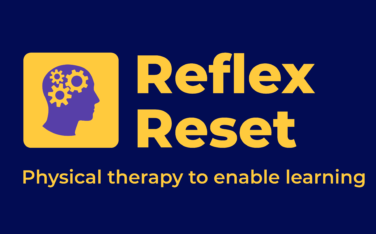Asymmetrical Tonic Neck Reflex (ATNR)
What is the ATNR?
The ATNR is triggered by rotation of the head – turning the head from left to right. If a baby’s head is turned to the right, his right arm and leg will extend or straighten and tone will be slightly increased on this side, hence why it is also known as the fencing reflex. His left arm and leg bend or flex. Turning his head to the left elicits the same pattern but this time there is extension in the left limbs and flexion in the right.
What is the purpose of the ATNR?
The purpose of the ATNR is firstly to assist in the process of a normal delivery, as the baby activates the ATNR to assist with moving down the birth canal. The ATNR will also help the neonate who is prone (on his tummy) to free his mouth and nose for breathing. It makes the baby aware of homolateral movement; that is, movement on the same side of the body.
As the baby grows, it is believed that the ATNR strengthens hand-eye coordination. A new infant has a fixed gaze distance of about 17 cm and his eyes are drawn to the periphery of objects close to him. The ATNR alerts the baby to the existence of his hand – when he turns his head to one side his hand will appear on that side and the movement will catch his eye – and it allows the baby to alternate between near point peripheral vision, when his head is centrally placed and his hands in front of his face, to focal vision when he follows his hand and focuses at arm’s length.
What happens if the ATNR is retained?
A child with a retained ATNR can present with one or more of several issues, most as a result of the interference caused to normal physical development and the subsequent effects on learning. An ATNR child is always being forced into the pattern of the ATNR, albeit in a slight and perhaps unobvious fashion, rather than being able to undertake voluntary movement desired. This can be frustrating for the child and compromises his full physical development.
– Inability to roll over or commando crawl
This is because the retained ATNR prevents head rotation and flexion/bending on the same side. If you turn your head to the right, you need to be able to bend your right arm and leg to roll over to the right. Commando crawling requires the ability to have the right arm and left leg flexed/bent at the same time and then pushing through to extension/straightening of these limbs to propel oneself forwards. A retained ATNR may result in homologous movement instead – both arms are used together to pull the body forwards and the legs may just drag behind or are used together too. Crawling and creeping, important for cross-pattern development which enhances hand-eye coordination and integration of vestibular information, will be compromised with a retained ATNR.
– Balance
In standing a child will feel unstable and insecure unless his head is held still and in the midline. Turning his head will make his leg on the opposite, occipital side (the back of the head side) feel weak due to slight lowering of tone. In all other positions, the effect will be the same, although perhaps not so marked. When walking, the child’s gait may look strange especially if he swings his left arm forward with his left leg (rather than opposite arm and leg) in a homolateral/one sided pattern.
– Difficulty with reading and writing
 Difficulty crossing the midline causes a series of issues. A child needs to learn, through movement, that both sides of the body, the page, the pathway across the carpet of his car can be traversed through the midline. There may be difficulties in: manipulating an object with both hands and passing the object between hands which may not be learnt properly: writing is compromised, as is reading, because it is necessary for the hand to go to the other side of the page and for eyes to scan and track across a page in unison: cross-laterality or mixed laterality is a consequence – the child does not have a dominant side, so has to consciously think which hand to use rather than automatically using the dominant hand. Visual-perceptual difficulties, such a symmetrical presentation of figures or symbols on a page, may be seen.
Difficulty crossing the midline causes a series of issues. A child needs to learn, through movement, that both sides of the body, the page, the pathway across the carpet of his car can be traversed through the midline. There may be difficulties in: manipulating an object with both hands and passing the object between hands which may not be learnt properly: writing is compromised, as is reading, because it is necessary for the hand to go to the other side of the page and for eyes to scan and track across a page in unison: cross-laterality or mixed laterality is a consequence – the child does not have a dominant side, so has to consciously think which hand to use rather than automatically using the dominant hand. Visual-perceptual difficulties, such a symmetrical presentation of figures or symbols on a page, may be seen.
– Poor hand-eye coordination
Poor visual-motor integration (hand-eye coordination) can be marked in a child with a retained ATNR because, whilst the child may be able to cope with reading by compensating for eye movements alone, writing needs both hand and eye movements to be accurate and controlled. A child may quickly learn coping strategies for reading and writing; he may sit differently with his arm out straight; he may turn the paper or book to an angle which suits him better rather than having these usually aligned; his pen grip may be very tight or unusual to override the desire for his hand to open when the head is turned towards it.
– Difficulty with ball skills or swimming
Awkwardness or a slightly different way of moving in comparison to his peers may cause the ATNR child angst. His ball skills may be below par and he might appear clumsy when catching or kicking a ball. In the swimming pool, his backstroke will be fine (his head is kept in the midline) but his front crawl may only be half right – as he turns his head to breathe, the arm on that side will want to move away from his body, not go smoothly towards his ear in line with his body. If he has not developed dominance, he may be fractionally slower than his peers in various school situations while he has to actively choose between right or left. His motor planning skills – the desired intent from a movement – and the reaction of his body will be poorly matched because the ATNR kicks in following his turning/rotation of his head before he has time to think.
– Difficulty in the classroom
Cognitive effects may be seen. The subconscious effect required to override a retained ATNR is energy-sapping. A child with an ATNR may be very capable orally in the classroom but, when writing is required or under stress, such as in an exam, he may well appear to ‘let himself down’ or perform below the level expected of him. The fluency required to think and write at the same time seems to be blocked. This is frustrating for all concerned but is a true effect of a retained ATNR and is not the child’s ‘fault’.
